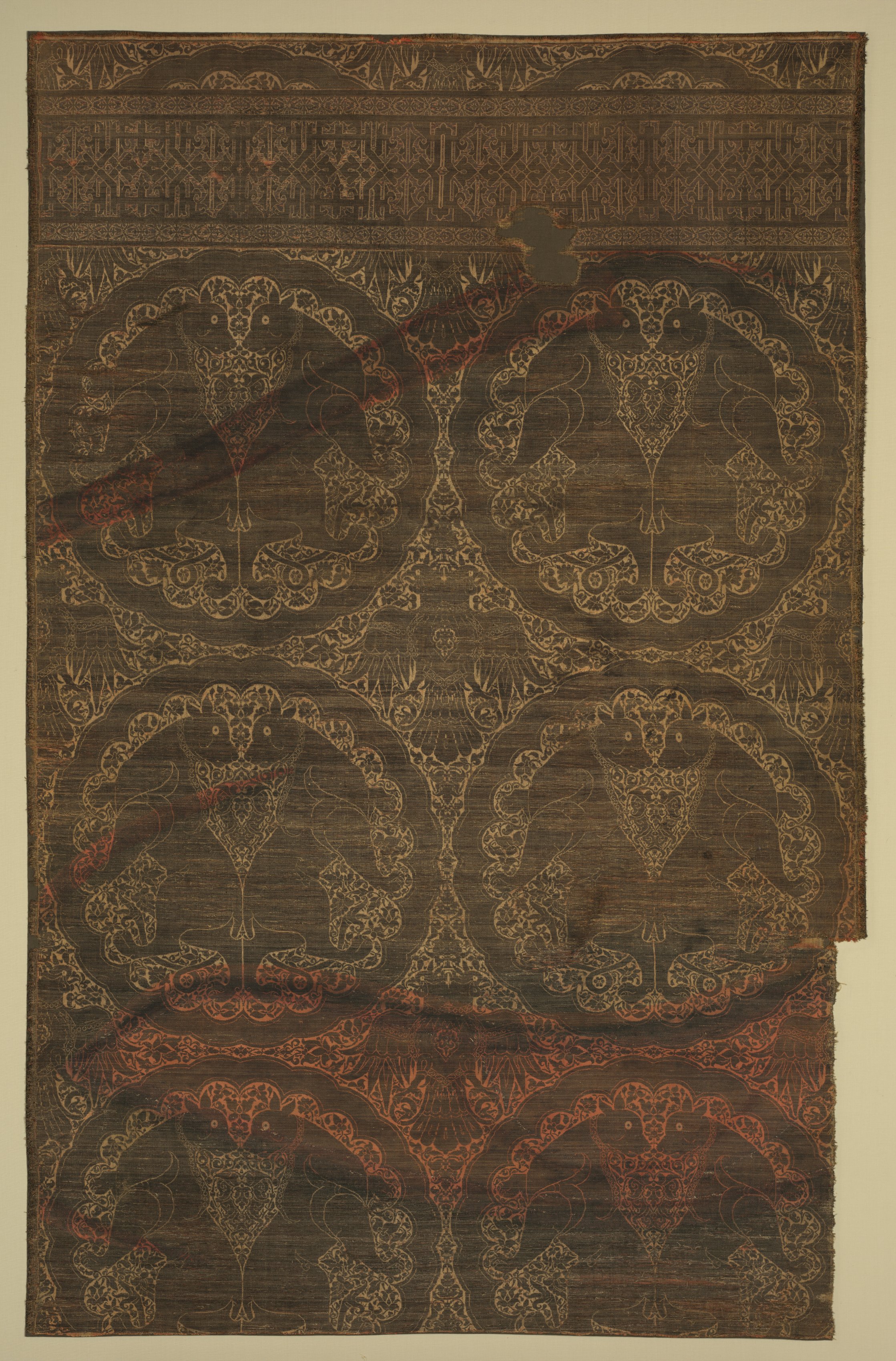The Cleveland Museum of Art
Collection Online as of April 20, 2024

Cloth of gold with felines and eagles
1225–75
Overall: 170.5 x 109 cm (67 1/8 x 42 15/16 in.)
Location: not on view
Did You Know?
Mongol cloths of gold, called nasji, incorporate Iranian, Central Asian, and Chinese features, reflecting the effects of gift exchanges and international commerce.Description
Mongol taste for luxury was equated with gold, symbol of imperial authority, power, and legitimacy. This splendid cloth of gold-exceptionally large and luxurious-may have enriched the interior of a palace or a majestic tent. The golden pattern, although tarnished on the faded red silk ground, features scalloped medallions with felines whose long tails terminate in dragons’ heads amid elegant floral vines. Double-headed eagles form interstitial motifs on the floral ground. A radiant gold-on-gold band of pseudo-Arabic script enriches the top, woven with gold strips wrapped around a silk core on a ground of flat strips of gold, immediately beneath the pattern testing area.- 1988?-1990(Thupten Zong Lo, Hong Kong, sold to the Cleveland Museum of Art)1990-The Cleveland Museum of Art, Cleveland, OH
- Handbook of the Cleveland Museum of Art. Cleveland, OH: The Museum, 1991. p. 47 archive.orgWardwell, Anne E. "Notable Acquisitions." The Bulletin of the Cleveland Museum of Art 78, no. 3 (1991): 63-147. Reproduced and Mentioned: p. 123 www.jstor.org"Exhibitions, Golden Lampas." HALI; the international journal of Oriental carpets and textiles 13 no. 59 (June 1991): 125. p. 125Wardwell, Anne E. "Two Silk and Gold Textiles of the Early Mongol Period." The Bulletin of the Cleveland Museum of Art 79, no. 10 (1992): 354-78. Reproduced: cover, pp. 359-361, 377-378, fig. 5; Mentioned: pp. 354-378 www.jstor.orgWardwell, Anne E. "Important Asian Textiles Recently Acquired by the Cleveland Museum of Art," Oriental Art N.S. 38 no.4 (Winter 1992/93): 249. p. 249Reynods, Valrae, "Silk in Tibet: Luxury Textiles in Secular Life and Sacred Art," The Second Hali Annual: Asian Art, ed. Jil Tilden (London, 1995): 86-97. no. 7Watt, James C. Y., Anne E. Wardwell, and Morris Rossabi. When silk was gold: Central Asian and Chinese textiles. New York: Metropolitan Museum of Art in cooperation with the Cleveland Museum of Art: Distributed by H.N. Abrams, 1997. Mentioned and Reproduced: no. 43, fig. 53, 60, 61; pp. 128, 133-134, 154-155Bonhams Knightsbridge. Islamic Works of Art including two 'Fostat Carpet' Fragments. 21 April 1999. p. 62, fig. bKuhn, Dieter, Feng Zhao, Juanjuan Chen, Nengfu Huang, Wenying Li, Hao Peng, and Feng Zhao. Chinese Silks. New Haven, CT: Yale University Press, 2012. p. 338Highet, Juliet. "Silks from Islamic Lands." The Asian Art Newspaper: Monthly for Collectors, Dealers, Museums and Galleries 17, issue 5 (March 2014):16-18. Reproduced: p. 16Mackie, Louise W. Symbols of Power: Luxury Textiles from Islamic Lands, 7th-21st Century. Cleveland, OH; New Haven, CT: The Cleveland Museum of Art; Yale University Press, 2015. Reproduced: P. 210, 217, 219, fig. 6.4; Mentioned: P. 180, 215, 226. 227Mühlemann, Corinne. Complex Weaves: Technique, Text, and Cultural History of Striped Silks. Affalterbach: Didymos-Verlag, 2023. Mentioned and reproduced: p. 159-160, figs. 77-78
- Luxuriance: Silks from Islamic Lands, 1250-1900. The Cleveland Museum of Art, Cleveland, OH (organizer) (May 14, 2013-June 23, 2014).When Silk Was Gold: Central Asian & Chinese Textiles from the Cleveland and Metropolitan Museums of Art. The Cleveland Museum of Art, Cleveland, OH (October 26, 1997-January 4, 1998); The Cleveland Museum of Art, Cleveland, OH (October 26, 1997-January 4, 1998); The Metropolitan Museum of Art (organizer) (March 2-May 17, 1998); The Metropolitan Museum of Art (organizer) (March 2-May 17, 1998).Notable Acquisitions. The Cleveland Museum of Art, Cleveland, OH (organizer) (June 7-September 15, 1991).
- {{cite web|title=Cloth of gold with felines and eagles|url=false|author=|year=1225–75|access-date=20 April 2024|publisher=Cleveland Museum of Art}}
Source URL:
https://www.clevelandart.org/art/1990.2